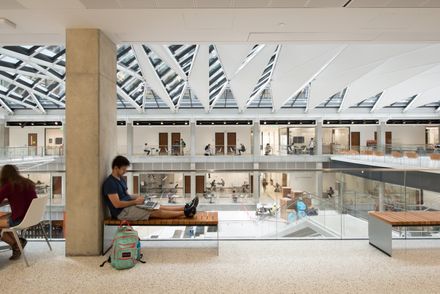ARCHITECTS
Ennead Architects, Jacobs Engineering Group, Inc.
LOCATION
Austin, United States
CATEGORY
University
AREA
430000 ft²
YEAR
2017
PHOTOGRAPHS
Aislinn Weidele, Cockrell School of Engineering
PROJECT LEADER
Todd Schliemann, Kevin McClurkan
MANUFACTURERS
MetalTech-USA, Morin Corp., VMZINC, Carl Stahl, Lindner, Linel, RPG, Series Seating, elZinc, Harmon, Legacy Masonry, RGM
COLLABORATORS
Jacobs Engineering Group, Inc; Bryan Floth
CLIENT
UT Austin
BUDGET
$310 million
Over seven years in the making, the EERC defines a new approach to engineering education through the integration of undergraduate project-based learning and interdisciplinary graduate research, with state-of-the-art classrooms, large-scale labs, and maker spaces.
It includes the 23,000 square foot National Instruments Student Project Center, designed to place the most advanced tools in engineering research into the hands of undergraduates, the James J. and Miriam B. Mulva Auditorium and Conference Center, the Cockrell School’s largest event space, the Texas Instruments teaching and project labs, and the Center for Innovation, the school’s first space dedicated to entrepreneurship and moving revolutionary ideas to market at a faster rate.
The building’s design, centered around the idea of “Transparency and Unification,” defines a new paradigm for engineering education and research through the integration of undergraduate project-based learning, interdisciplinary graduate research, and a Center for Innovation focused on entrepreneurship.
Given the school’s strategic and programmatic needs, the building is organized into two nine-story limestone and glass towers, acknowledging the substantially different requirements for labs, offices, and workspaces of the Department of Electrical and Computer Engineering and interdisciplinary graduate research.
The two towers, with inwardly-oriented glass curtain wall facades, are connected by an enclosed three-story atrium with a folded glass and steel roof, creating a vibrant, light-filled public space, which is the social heart of the building meant to facilitate “productive collisions” between faculty, staff, students and campus visitors.
Bridges and staircases create circulation paths throughout and join the different research environments.
Prominently visible through floor-to-ceiling glass along the north wall of the atrium is the National Instruments Student Project Center, dedicated to project-based interdisciplinary learning.
Its honest expression of raw concrete, fully exposed mechanical systems and glass walls from room to room puts engineering, and engineering education, on full display.
Architectural gestures throughout the building were designed to elevate and celebrate engineering principles – from the steel truss systems spanning the towers to the intricate spiral staircase, from the delicate “V” column underneath the staircase to the sky bridges connecting the floors.




















